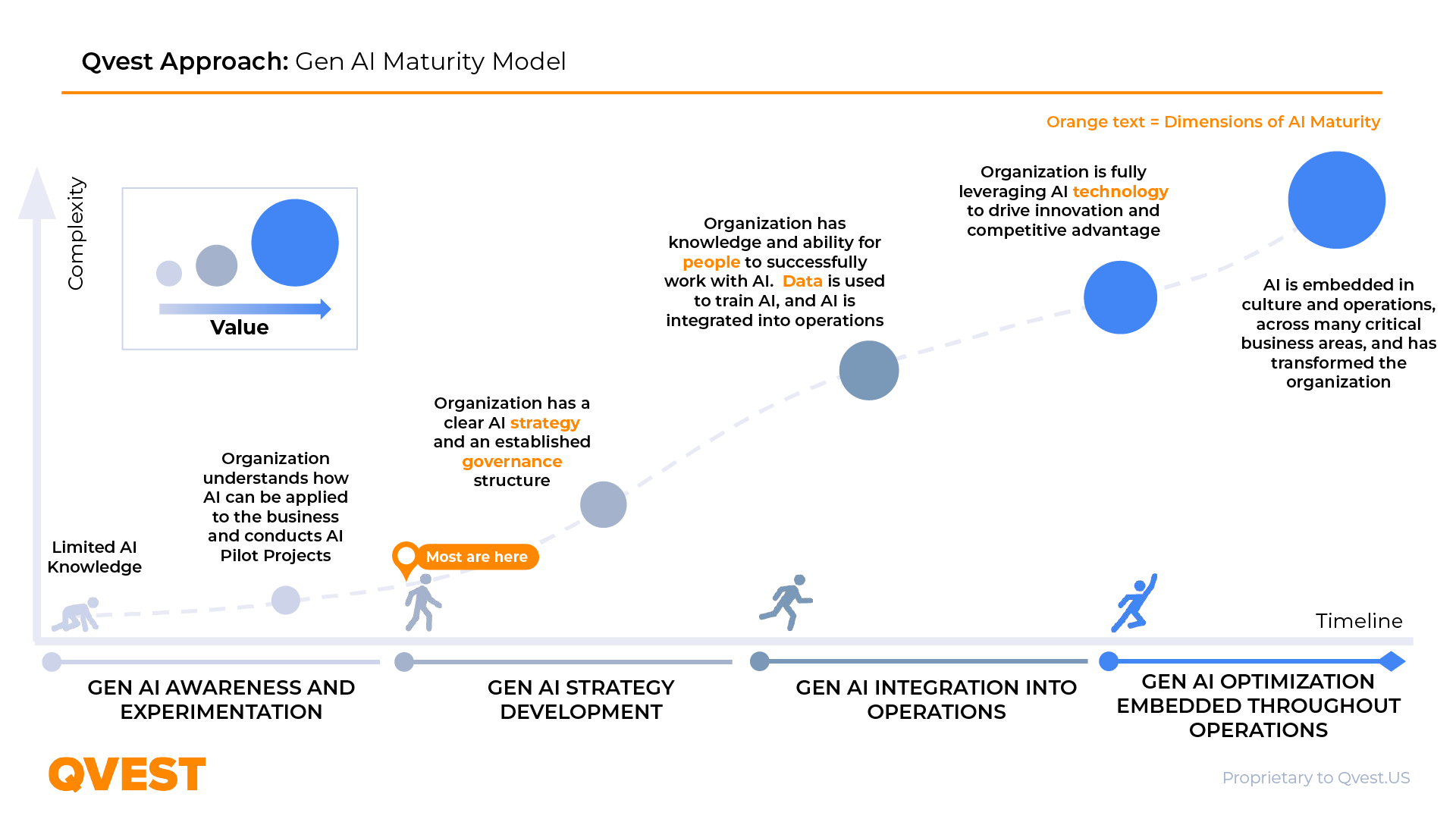
GenAI stole the NAB Show 2024
5 GenAI themes from NAB 2024
The star of this year’s NAB Show was GenAI. Thousands of broadcast, media and entertainment executives descended on Las Vegas to discuss the future of the industry and all anyone could talk about was the tech that talks. The big question: who’s actually putting their AI talk into action and how are they doing it?
After the show, Qvest US’ GenAI leaders, Christophe Ponsart and Vanessa Fiola; Digital Media Supply Chain Leader, Jon Christian and Broadcast Transformation Leader, Tim Day - came together to compare notes on the key themes of the conference. Register and listen to the full discussion here.
Everyone agreed that GenAI dominated the conversation and is poised to transform studio and media operations across the board. However, other forces are holding companies back from using GenAI to realize the full promise of big ideas like personalized consumer experiences and story-driven newsrooms. A crowded vendor marketplace is creating noise and companies are left to decipher where to start and what technology to buy or build on their own. Following are five themes that emerged from our NAB wrapup.
Theme #1: Hyperpersonalization will shape content for viewers, but….
The evolution from traditional linear distribution (satellite/cable) to IP has paved the way for powerful personalization. Now, with GenAI, consumers can expect hyper-personal experiences at supersonic speeds. Data overlaid on apps will enable immersive fan experiences like never before. “For instance, the impact on sports will prove especially meaningful with exciting developments such as personalized playviews and game stats”, said Christian.
However, while many vendors at the show focused on the consumer-facing generative AI capabilities, the reality is that adoption for those technologies is more complex. Although-consumer facing capabilities are flashy and impressive, there is a higher quality-bar to clear, as well as more risk to avoid, which makes cyber validation challenging. In contrast, internal-facing initiatives have a higher possibility of rapid experimentation and deployment.

When it comes to GenAI, you really have to crawl, walk and then run.
The process was shown through our GenAI Maturity Curve (visualized below). A lack of experience due to legal and cybersecurity concerns might be why media executives are hesitant to use GenAI for content production and are more comfortable with implementations in backend operations.
According to Ponsart, getting started begins with awareness and the vast majority of media companies are heading in the right direction. Qvest’s recent analysis shows that 80% of major studios & networks have established AI councils and/or task forces. Nearly all of them are in the proof of concept phase (PoC) and most are around copilot for enterprise, copilot for services areas, localization and content optimization.

Theme #2: AI buzz vs. real offerings and implementation
The media’s reluctance to push out consumer-facing GenAI has consequences. According to Devoncroft, more than 1,100 vendors at NAB were talking about AI and machine learning, yet fewer than 17% are actively selling it. There’s a difference between what’s possible and what’s practical. Remember, for as many use cases you have across the studio or network, you typically have centralized cyber and privacy teams that are capacity constrained.
Day explained, a media company’s willingness to engage in more forward-facing Gen AI’s depends on the size and scale of the company.
“We haven’t yet grasped the full impact of GenAI,” said Day. “Right now, we are focused on the backend. There’s a hesitancy to do content generation. However, with smaller, more nimble companies, there is less resistance to create content. If you're a startup and you have no legacy debt, you will see more advances in content generation. They can afford to be more aggressive than others.”
Theme #3: Vendor volatility in AI market demands flexible solutions
The turnover of technology tools creates uncertainty and underscores the urgency of agility. It’s costly for media companies to make investments in technology that is constantly improving. Also, myriad tools can muddy the investment landscape. For these media solutions, we recommend mastering no-code/low-code frameworks to more effortlessly integrate various models into workflows that can easily be adapted as those models evolve and change. As it relates to more operational use cases, everywhere you look Saas vendors are building copilots into their products and charging a premium, according to Ponsart. “Imagine costs mounting when you’re paying an individual copilot fee for every app across your enterprise,” said Ponsart.
In addition to the cost impacts of this approach, it is also not optimal from a user experience perspective as it can lead to user confusion. We believe a centralized copilot with access to data across the enterprise will provide an improved user experience as well as result in a more cost effective outcome. Low-code frameworks are being built by the large technology players to enable this type of extensibility providing a more flexible solution to deploying these capabilities.
Theme #4: GenAI will drive broadcast transformation by facilitating story-centric workflows
Broadcast businesses are under tremendous pressure to reduce costs and increase revenue. “The solution to that mounting pressure is shifting to story-centric newsrooms,” said Day. That means rather than organizing around the teams creating the news, such as dividing into linear vs. digital, broadcast companies make the story itself the heart of daily operations. This way, they have more opportunities to reuse content across channels, which GenAI is well suited to facilitate with support in areas such as script generation, transcription and closed-content generation.

The solution to that mounting pressure is shifting to story-centric newsrooms.
Theme #5: Media risks getting left behind by not putting their people first
All the panelists agreed that fear is in the air, when it comes to GenAI adoption. According to Fiola, adapting to GenAI is different than with previous technologies. More than ever, you have to consider adoption at the forefront of the conversation or expect unprecedented resistance. It’s critical to avoid moving faster than people can adapt. Fiola recommended starting small. “Take a bite-sized approach,” she said.

Take a bite-sized approach.
Don’t let fear prevent you from starting
Narrow down your use cases by what will create the biggest impact, contrasted with how you can limit risk. Then rank those use cases based on core criteria. Pick one or two and start in a POC phase. Whether using GenAI to extract key terms from contracts and import them into your rights management system – or integrating co-pilots with your enterprise data to have one co-pilot that accesses all your data – you can tap into GenAI’s practical use cases. For a demo, submit the fields below.

